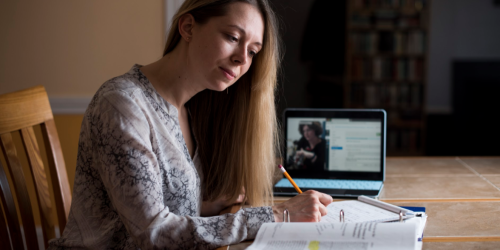By Sarah Matheny, TEEP Teacher Graduate
Sarah Matheny, Science and Design Thinking Teacher from St. George’s Independent School, Germantown, TN, shares her work with kindergarten and first grade students in an afterschool enrichment project with WeDo 2.0.
 I was a student in Tufts University’s first Teacher Engineering Education Program (TEEP). While working through the program I could not get enough of the LEGO NXT system we were given for prototyping solutions. I saw the platform as having endless engaging applications. I wanted to bring this quick build problem solving to the younger students I teach. I began using the LEGO WeDo 2.0 sets with kindergarten and first grade students. We spent time working through the different scripted builds, learning how the sensors, motors and programming worked. Very quickly, the students were extending the builds, changing wheel placement, increasing length, manipulating the code and of course adding the cute eyes. It was clear they were ready to break away from being told what to build and how to build it. They were ready to think creatively and solve problems using the LEGO WeDo system as their prototype.
I was a student in Tufts University’s first Teacher Engineering Education Program (TEEP). While working through the program I could not get enough of the LEGO NXT system we were given for prototyping solutions. I saw the platform as having endless engaging applications. I wanted to bring this quick build problem solving to the younger students I teach. I began using the LEGO WeDo 2.0 sets with kindergarten and first grade students. We spent time working through the different scripted builds, learning how the sensors, motors and programming worked. Very quickly, the students were extending the builds, changing wheel placement, increasing length, manipulating the code and of course adding the cute eyes. It was clear they were ready to break away from being told what to build and how to build it. They were ready to think creatively and solve problems using the LEGO WeDo system as their prototype.
 I am now in my sixth session of LEGO WeDo, with many of the same students having been with me all 6 sessions. They have grown to love the possibilities they can create and each session feels fresh and full of new possibilities. Lately, I have begun each class with a special task to complete. This particular week, I asked the students to create something that could go fast, then faster, then faster and ultimately cross the finish line. On the LEGO WeDo app there is a model library that helps students with the different mechanisms while not giving them instructions on a whole build. Students use this library when they are unsure how to get the motor to work for their idea. This particular task would require students to think through their design, write code that would change speed, problem solve through a fair test (some students began adding very long LEGO pieces to the front of their vehicle so that it would be longer and cross the finish line first), and make adjustments and improvements after each practice race. It was an hour full of fun, purposeful problem solving. Take a look at this video to see the races in action.
I am now in my sixth session of LEGO WeDo, with many of the same students having been with me all 6 sessions. They have grown to love the possibilities they can create and each session feels fresh and full of new possibilities. Lately, I have begun each class with a special task to complete. This particular week, I asked the students to create something that could go fast, then faster, then faster and ultimately cross the finish line. On the LEGO WeDo app there is a model library that helps students with the different mechanisms while not giving them instructions on a whole build. Students use this library when they are unsure how to get the motor to work for their idea. This particular task would require students to think through their design, write code that would change speed, problem solve through a fair test (some students began adding very long LEGO pieces to the front of their vehicle so that it would be longer and cross the finish line first), and make adjustments and improvements after each practice race. It was an hour full of fun, purposeful problem solving. Take a look at this video to see the races in action.



